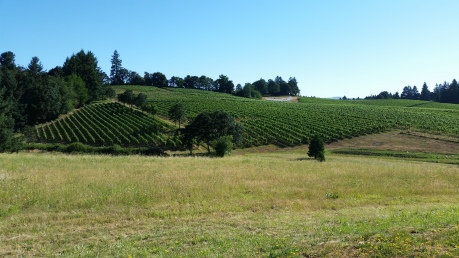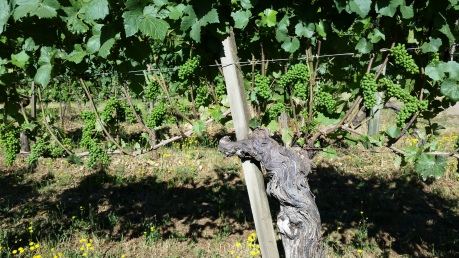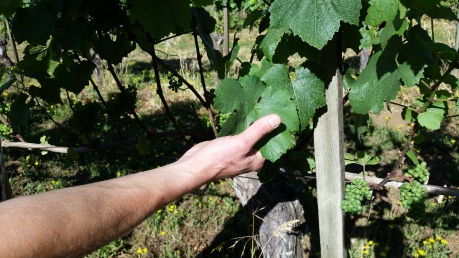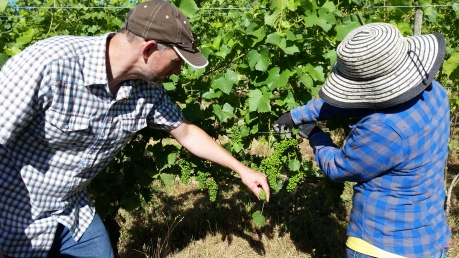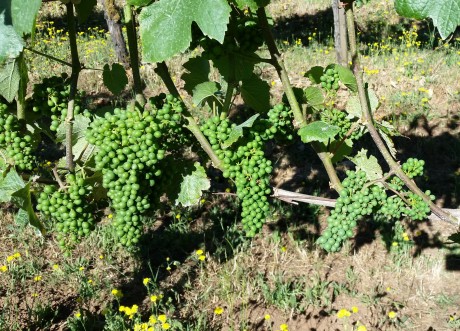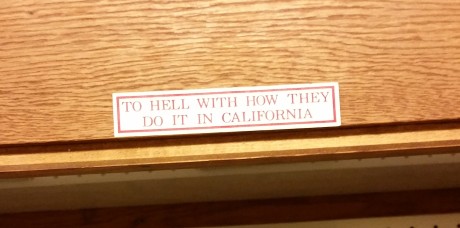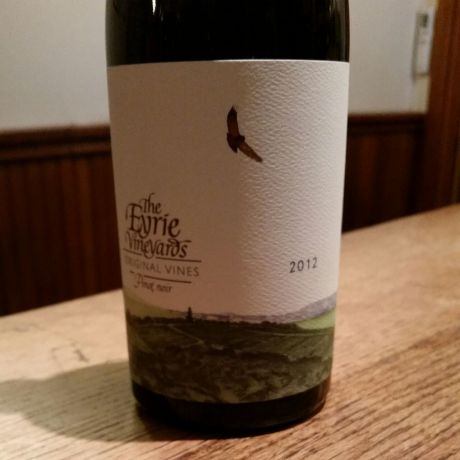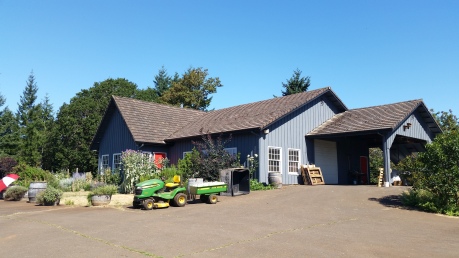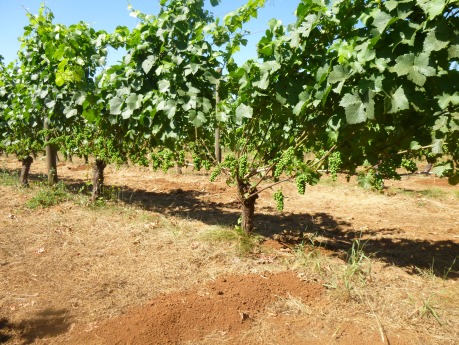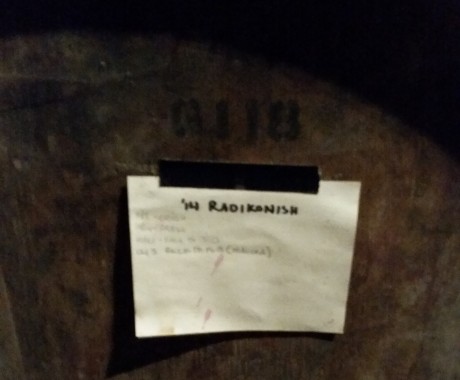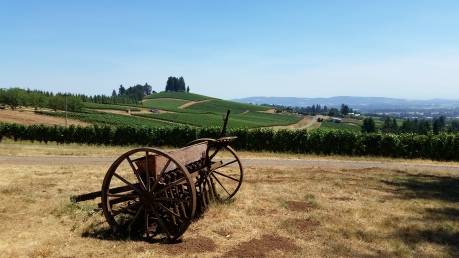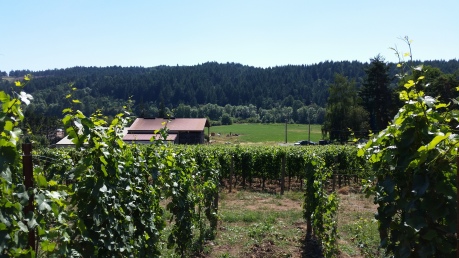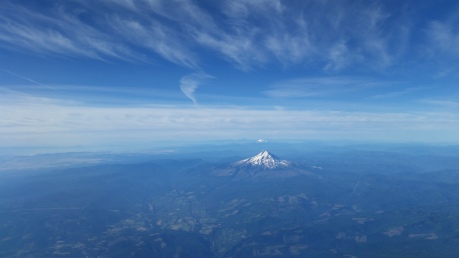What I Did Over My Summer Vacation
July 6, 2015
Day One
That’s the Eyrie Vineyard in the Red Hills of Dundee, Oregon. David Lett first planted here in 1965. The red-tailed hawks the winery was named after still nest in the tall evergreen at the top of the slope.
Eyrie’s Original Vines (still bottled under that name) include the first pinot noir in Oregon. The Original Vines section is above the break halfway up the hill, where the orientation of the rows changes from going up and down the hill to side-by-side. The plot on the left shaped like the lid of a grand piano used to be a section of the Eason Vineyard. Eyrie bought it in 2011 (you can see why!) and now bottles the old Eason vines as the Eyrie Outcrop Vineyard.
At 50 years old, the Original Vines are gnarly and as thick as a man’s neck.
Like many of the original plantings in Oregon, they are on their own roots, vitis vinifera all the way down. There is some phylloxera in the vineyard—the affected vines don’t produce as much foliage (or grapes).
Jason Lett found a dead soldier and brought it back to display in the tasting room.
The spots of soil peeking through the grass and wildflowers are red Jory clays dating to a volcanic eruption that covered the area 50 million years ago. The whole Dundee Hills area has darker or lighter variations of this.
Different clones are peppered throughout the vineyard more or less randomly. Above, Jason compares the leaves from two chardonnay plants. They’ll each ripen at their own pace and get harvested together. “It’s funny when someone picks everything at uniform ripeness and then throws it in 37 different kinds of oak to add complexity,” Jason remarked.
We got here in the middle of a heat wave—several days of 100-degree temperatures at high noon. Workers were clearing leaves from the bottom rows of the trellises where the grapes grow to help with ventilation. Most of the vineyards around here also have the vines trained higher up from the ground than in Burgundy for the same reason (and to keep them further away from the heat-retaining earth).
It’s going to be an early harvest this year. Jason Lett made the call not to prune the wings and shoulders—protrusions off the side like the one in the bunch on the right, which will ripen behind the rest of the cluster and act as a natural acidifier. He’d rather get the acid this way than by buying sackfuls of tartaric acid to pour into the vats in the winery, since there are many kinds of acidity in grapes but just one in the sacks.
Some of the barrels at the winery are thirty years old. There are other neutral vessels, too.
These wines don’t taste like other New World pinot noirs.
The Eyrie Vineyards 2012 Original Vines Pinot Noir is so profound I’m posting this even though the picture is out of focus. Don’t miss it! The new labels were painted by Jason Lett.
I am not normally one to photograph food, but if you are ever in McMinnville, Oregon, you need to get lunch at the Valley Commissary.
McMinnville’s main drag also hosts several tasting rooms I was not tempted to visit.
DAY TWO
Here are the gates to Cameron’s Clos Electrique vineyard (named after its electric fence). Looks kind of like Clos Vougeot, but much smaller.
The winery is above the vineyard near the top of the slope, like Clos Vougeot.
The vines here are also on their own roots—I spotted a bit of provignage going on.
There’s that red Jory soil again.
Most of the barrels in the winery are old, up to about ten years. New oak is only used for the entry-level wines. Assistant winemaker Tom Sivilli gave us the chance to taste some Clos Electrique and Abbey Ridge samples side by side—Abbey Ridge is older and higher up, so Electrique is a bit more plush, within the parameters of a style that’s about as Burgundian as it gets around here.
There are a few experimental barrels in the cellar. . . .
These vines and the giant basin of virgin Jory soil below are part of Domaine Drouhin Oregon.
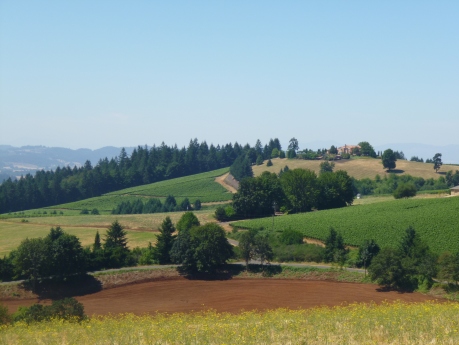
DDO is high up in the hills—worth a detour just for the view.
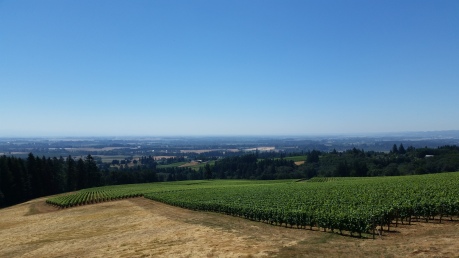
The rows are so neatly manicured it’s like they were tended by Martha Stewart.
The vines are densely planted in a more Burgundian fashion . . . but younger and hooked up to irrigation drips.
DAY THREE
Maresh Vineyard (pronounced Marsh) is further up the hill along the same road as Clos Electrique.

“Maresh isn’t a vineyard, it’s a farm,” says Kelley Fox, who works Maresh for her own label and used to make wines from here for Scott Paul. She farms biodynamically but realized early on that the vineyard didn’t really need it—the soil was already teeming with life.
This is Block One, across from the winery and a pair of 100-year-old chestnut trees. The vines were planted in 1970, which makes them some of the oldest in the Dundee Hills. The fruit here and in some other old blocks will go into the Kelley Fox Maresh Vineyard Pinot Noir. The 2012 was another highlight from the trip—solid and stony on the entry, perfumed with roses on the back end.
Patricia Green Cellars is just a quick drive away but in a completely different appellation—Ribbon Ridge. The soil is grey, marine instead of volcanic.
Kelley Fox had so many interesting things to say we talked her into coming along. Jim Anderson led us through a barrel tasting while he and Kelley dropped one knowledge bomb after another and I tried to avoid blurting out something stupid. My favorites were whole-cluster fermentations from the Durant Vineyard and the Freedom Hill Vineyard, both intensely mineral wines that turned from fruit to stone on the palate.
We were also joined by Chompers the dog.
The Estate vineyard was already planted when Patricia Green and Jim Anderson bought the property fifteen years ago. But the rows were widely spaced, so they interplanted new rows between them to increase the density.
Then Jim took us to a younger section of the vineyard they’ve been calling El Fuego. In the space of a six-foot-wide footpath separating it from the older vines below, the soil turns much blonder and the temperature contrast is like stepping into a hot car. (That’s why it’s called El Fuego.) Above, Chompers bemoans having no sweat glands and Kelley Fox attempts to take refuge in the shade.
Fin.
